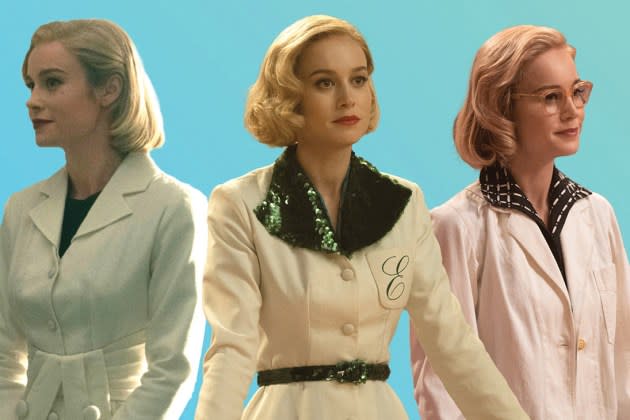Brie Larson’s Lessons of Fashion Artistry Behind ‘Lessons in Chemistry’

Mirren Gordon-Crozier has worked with Brie Larson on four projects in the past 10 years, beginning with the actress’ breakout role in the 2013 independent drama Short Term 12. Yet when the costume designer heard Larson’s next lead part was in a period TV series, “I almost fell to the ground,” she says.
What most excited Gordon-Crozier about coming on board was the span from 1949 to 1957 that’s covered in Lessons in Chemistry, the Apple TV+ adaptation of Bonnie Garmus’ novel of the same name in which Larson stars as Elizabeth Zott, a chemist turned cooking show star who’s navigating stifling gender norms amid love and loss. Gordon-Crozier talked with THR about the defining style of that period and the story Zott’s clothes tell in the series.
More from The Hollywood Reporter
Robert Downey Jr. Says His 'Sympathizer' Hair and Makeup Was a "Very Surreal Experience"
'Baby Reindeer' Actress Jessica Gunning: "I Don't Think There Will Be Another Role Like Martha"
Tonys Producers on Changes For This Year's Show, 'Stereophonic' and Their Plan to Honor Plays
Were there real-life figures that inspired the series’ wardrobe direction?
Definitely, but it was their off-duty wardrobe rather than what we’ve seen on camera. So what Grace Kelly would wear behind the scenes, and Lauren Bacall, and Audrey Hepburn, naturally. I did a lot of research into what they wore on the weekends with their family and built shapes and silhouettes based on that.
The series opens with Zott wearing pants to the set of her show, which causes some whispers. Talk about that choice.
There’s a dress code that a lot of women had to abide by, especially in her work environment at the lab. I’m sure she would have chosen to wear pants if she could, but if she wanted to keep her job, she had to wear a skirt and her saddle shoes. So when she had the opportunity, which is the moment where she’s really running the show, she comes out wearing a pair of slacks, which is very rare, especially on TV. It was a pivotal moment.
How did you decide how you wanted Zott’s wardrobe to progress as she goes through these personal and professional transformations?
We used a lot of color for that, especially different shades of green. For every new phase, we chose green tones, even if it was just a small print with green in it. Her palette stayed the same, it was just her style that evolved. In the beginning, she wore a lot more masculine prints. I got these vintage vests that were in the boys’ section at Western Costume because I couldn’t find anything I wanted for her in the women’s department. I was doing little things like that, going outside the box, as I think she would want to as well. It’s a fine line for her fitting in with the men and the women. She didn’t want to cause any problems.
As she becomes a successful TV show host, her style evolves, and she takes her lab coat with her, and that’s where we started to have fun with it. We made all her lab coats custom. A lot of the inspiration came from Christian Dior. There’s an exhibit I saw in Paris, and when you came in, it was all white dresses, and those were the samples that he did to get his silhouette. From that idea, I thought it would be amazing to have all these different fabulous white coats as opposed to just leaving her in a standard lab coat.
How much of the wardrobe did you source versus make?
A lot of the things we sourced were knitwear, because it’s quite hard to make knitwear. We made all her lab coats. We made a lot of her skirts. The most challenging part is always finding the period-appropriate fabric and textiles. Some fabric stores have deadstock fabric from the ’50s, and that’s what you want to look out for because you have to make multiples. A pleated skirt is a lot of fabric, usually five yards, so finding the right fabric is key because textiles now are different color combinations than what was popular in the ’50s.
Women’s clothing wasn’t the most comfortable during this period. Did you try to mitigate that at all?
I think it helps a lot with the character, especially someone like Fran [Elizabeth’s frenemy, played by Stephanie Koenig], who’s very uptight. I think she enjoyed putting on the layers and seeing how constricting it was. It also helps with your posture and the way you stand, especially wearing heels and being slightly uncomfortable in your clothes, because that’s what they had to deal with. Brie was very much Elizabeth in the sense of “I feel like they’ll never notice,” but I think she enjoyed her costumes.
What are you most proud of pulling off?
I could go on forever about the lab coats, because it’s nice being restricted in a color palette and a silhouette and then seeing how creative you can be with the collar, or the belt, the finishings and the trims
This story first appeared in a June standalone issue of The Hollywood Reporter magazine. Click here to subscribe.
Best of The Hollywood Reporter

 Yahoo News
Yahoo News 